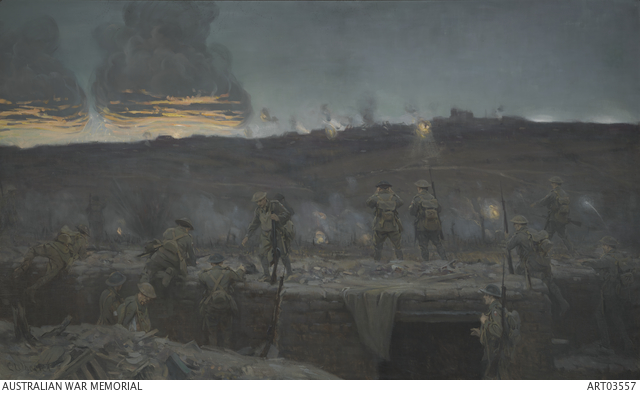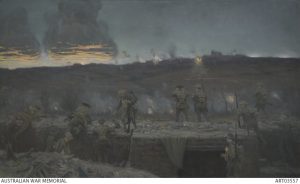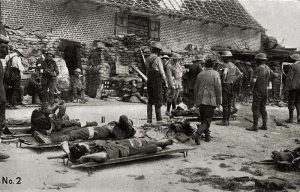At 3.10 am on 7 June 1917 Australian forces detonated 19 underground mines below German trenches on Hill 60, south of Ypres, heralding the beginning of the Battle of Messines. The blast consisted of 450,000 kilograms of explosives and completely destroyed the German front line at the northern end of Messines Ridge, killing some 10,000 German soldiers. The explosion was one of the largest in history, with an impact that was reportedly heard in London and Dublin. Official Australian war correspondent CEW (Charles) Bean described the explosion:
At 3.10 a number of big guns began to fire and then the trench-walls rocked; to the left, near Wytschaete, a huge bubble was swelling, mushroom-shaped, from the earth, and then burst to cast a molten, rosy glow on the under-surface of some dense cloud low above it. As its brilliance faded two more bubbles burst beside it. During twenty seconds the same thing happened again and again, from the right to the far left. The nineteen great mines had been exploded. With a roar the machine-gun barrage broke out. The massed artillery was already firing. The ridge faded from view, and for two hours nothing could be seen of it from Hill 63 through a fog of smoke and dust.
British, New Zealand and Australian infantry launched into action following the explosion, employing the creeping barrage tactic, supported by the artillery and taking the surviving Germans by complete surprise. Messines was the first time Australians and New Zealanders had fought side by side since the Gallipoli campaign of 1915. It has been argued that the Battle of Messines was the most successful local operation on the Western Front, if not of the entire war. Official AIF photographer Frank Hurley later described the scene at Hill 60:
Here the awfulness of the battlefield burst on one. The great howitzer batteries were in full operation and the ear-splitting din was followed by the scream of a hail of shell which swept over our heads to the enemy lines… We plodded through shell craters and shell-torn ground littered with fragments of burst shell and shrapnel, torn equipment and smashed entanglements, over the blood-drenched battlefield till we arrived at the famous Hill 60.
What an awful scene of desolation! Everything has been swept away: only stumps of trees stick up here and there… It’s the most awful and appalling sight I have ever seen. The exaggerated machinations of hell are here typified. Everywhere the ground is littered with bits of guns, bayonets, shells and men. Way down in one of these mine craters was an awful sight. There lay three hideous, almost skeleton decomposed fragments of corpses of German gunners. Oh the frightfulness of it all. To think that these fragments were once sweethearts, maybe husbands or loved sons, and this was the end. Almost back again to their native element but terrible. Until my dying day I shall never forget this haunting glimpse down into the mine crater on Hill 60.
When fighting ceased on 14 June Allied casualties numbered 24,562, and German casualties 25,000 with 10,000 missing and 7,200 taken prisoner. 6,799 Australian casualties were sustained in the Battle of Messines. Nine men from the Orange district died during the conflict; seven of them on the opening day of battle.
William Clement
George Edgar Lockie
Luke Hughes
Bertie Stibbard
Albert James Rich
John Joseph Cullen
Frederick Peppernell
Walter Arthur Horace Higman
John Wright



